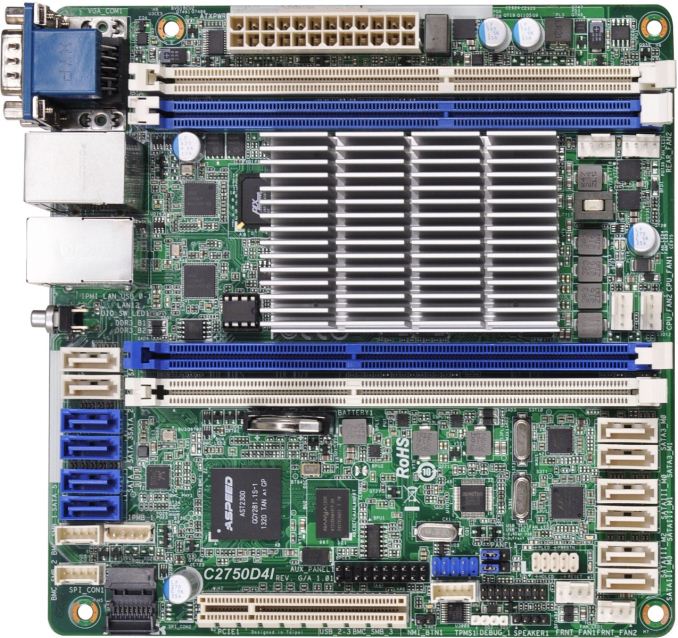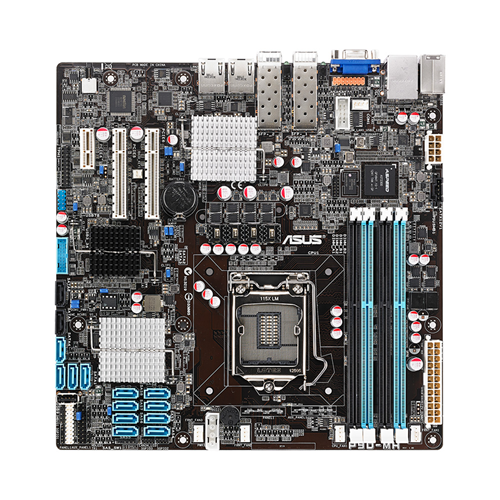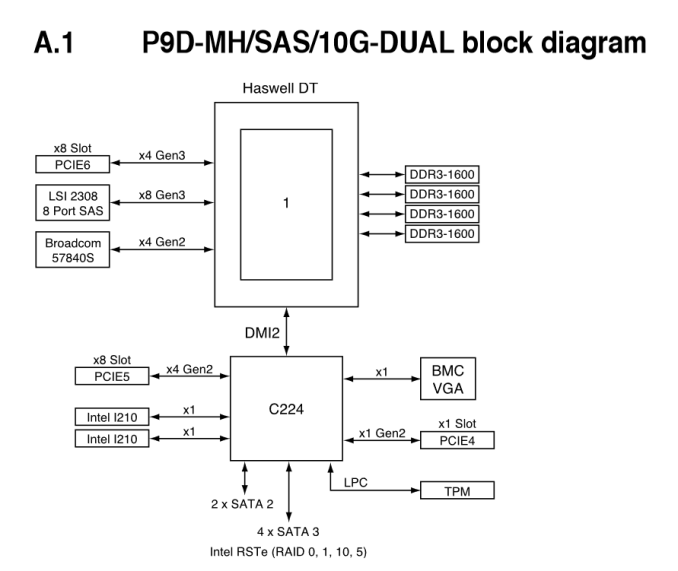X-Gene 1, Atom C2000 and Xeon E3: Exploring the Scale-Out Server World
by Johan De Gelas on March 9, 2015 2:00 PM ESTLow-End Server Building Blocks
Micro and low-end servers come in all shapes and forms. Ideally, we would gather them all in our labs and make a performance per watt comparison, taking the features that make management easier into account. The reality is that while lots of servers enter our lab, many of the vendors cannot be easily convinced to ship heavy and expensive server chassis with a few tens of nodes.
In AnandTech tradition, we decided to take a look at the component level instead. By testing simple motherboard/CPU/RAM setups and then combining those measurements with the ones we get from a full blown server, we can get a more complete picture. A simple motherboard/CPU/RAM setup allows us the lowest power numbers possible, and a full blown server measurement tells us how much the more reliable cooling of a full blown server chassis adds.
ASRock's C2750D4I
The mini-ITX ASRock C2750D4I has the Atom "Avoton" C2750 SoC (2.4GHz, eight Silvermont cores) on board. If you are interested in using this board at home, Ian reviewed it in great detail. I'll focus on the server side of this board and use it to find out how well the C2750 stacks up as a server SoC.
Contrary to the Xeon E3, 16GB DIMMs are supported. The dual-channel, four DIMM slot configuration allows you to use up to 64GB. This board is clearly targeted at the NAS market, as ASRock not only made use of the six built-in SATA ports (2x SATA 6G, 4x SATA 3G) of the Atom SoC but also added a Marvell SE9172 (2x SATA 6G) and a Marvell SE9230 (4x SATA 6G) controller. Furthermore, ASRock soldered two Intel i210 gigabit chips and an AST2300 to the board. However, the Atom "Avoton" integrated 16 PCIe lanes only support four PCIe devices. The PCIe x8 slot already needs eight of them and the Marvel SE9230 takes another two PCIe lanes, so the ASRock board needs a PLX 8608 PCIEe switch.
The end result is that the ASRock C2750 board consumes more energy at idle than a simpler micro server board would. We could not get under 26W, and with four DIMMs 31W was needed. That is quite high, as Supermicro and several independent reviews report that the Supermicro A1SAM-2750F needs about 17W in the same configurations.
ASUS P9D-MH
The micro-ATX ASUS P9D-MH is a feature rich Xeon E3 based board. ASUS targets cloud computing, big data, and other network intensive applications. The main distinguishing feature is of course the dual 10 Gigabit SFP+ connectors of the Broadcom 57840S controller.
The C224 chipset provides two SATA 3G ports and four SATA 6G ports. ASUS added the LSI 2308 controller to offer eight SAS ports. The SAS drives can be configured to run in a RAID 0/1/10 setup.
The Xeon E3-1200v3 has 16 integrated PCIe 3.0 lanes. Eight of them are used by the LSI 2308 SAS controller, and the 10 Gigabit Ethernet controller gets four fast lanes to the CPU. That leaves four PCIe 3.0 lanes for a mechanical x8 PCIe slot.
The second x8 PCIe slot gets four PCIe 2.0 slots and connects to the C224 chipset. The remaining PCIe 2.0 lanes are used by the BMC, the PCIe x1 slot, and the dual gigabit Ethernet controller.
Of course, all these features come with a price. With the efficient Xeon E3-1230L (25W TDP) and four 8GB DIMMs, the board consumes 41W at idle.













47 Comments
View All Comments
IBleedOrange - Monday, March 9, 2015 - link
EETimes is wrong.Google "Intel Denverton"
beginner99 - Monday, March 9, 2015 - link
Maybe it would be good to mention the X-Gene is made on a 40nm process at the start of the article. I read the article and think for myself that the X-Gene is crap and in the end you get the explanation. It's on 40 nm vs Atoms on Intel 22 nm. It's a huge difference and currently the article is a bit misleading eg. shining a bad light on X-Gene and ARM. (And I say this even though I always was a proponent of Intel Big cores in almost all server applications).Stephen Barrett - Monday, March 9, 2015 - link
If APM had a newer part to test then we would have tested it. XG2 is simply not out yet. So the fact that APM has their flagship SoC on an older process is not misleading... Its the facts. The currently available Intel parts have a process advantage.warreo - Monday, March 9, 2015 - link
Mentioning it at the start would be good from a technical disclosure standpoint, but I'm not sure for the purposes of this article it truly matters. The article is comparing what is currently available now from APM and Intel. Reality is Intel will likely have a significant process advantage for the foreseeable future, and if you wanted to see a like for like comparison on a process basis, then you'll probably need to wait 2-3 years for X-Gene to get on 22nm, meanwhile Intel will have moved on to 10nm.CajunArson - Monday, March 9, 2015 - link
The 40nm process is only really relevant when it comes to the power-consumption comparisons.A 28nm.. or 20nm or 16nm... part with the same cores at the same clockspeeds will register the exact same level of performance. The only difference will be that the smaller lithographic processes should provide that level of performance in a smaller power envelope.
JohanAnandtech - Monday, March 9, 2015 - link
well, with so much time invested in an article, I always hope people will read the pages between page 1 and 18 too :-p. It is mentioned in the overview of the SoCs on page 5 and quite a few times at other pages too.colinstu - Monday, March 9, 2015 - link
what server is on the bottom of the first page?JohanAnandtech - Monday, March 9, 2015 - link
A very old MSI server :-). Just to show people what webfarms used before the micro server era.Samus - Monday, March 9, 2015 - link
I use the Xeon E3-1230v3 in desktop applications all the time. It's basically an i7 for the price of an i5.And a lot of IT dept dump them on eBay cheap when they upgrade their servers. They can be had well under $200 lightly used. The 80w TDP could theoretically have some drawbacks for boost time, but the real-world performance according to passmark elongated tests doesn't seem to show any difference between it's boost potential and that of an 88w i7-k
Great CPU's.
Alone-in-the-net - Monday, March 9, 2015 - link
In both your compilers, you need to specify the -march=native so the the compiler can optimize for the architecture you are running on, -o3 is not enough. This enables the compiler to use cpu specific commands.